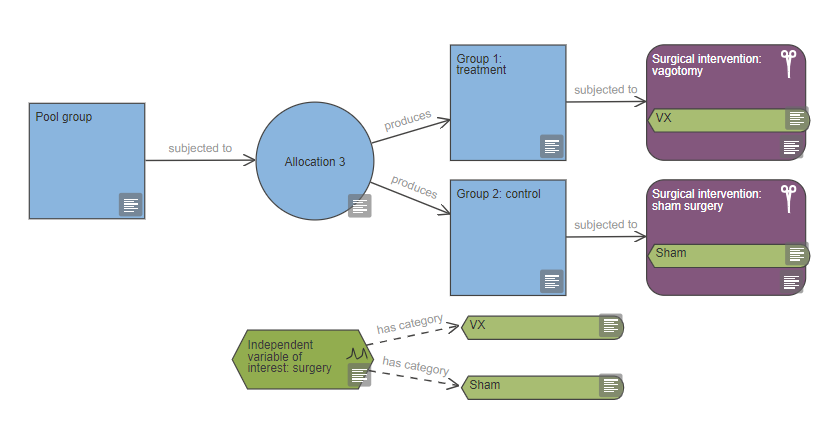Intervention
Key considerations for different types of interventions used in an in vivo experiment.
- Considerations for different types of intervention
- Reducing bias when administering interventions
- Representing different interventions in the EDA
An intervention is a process which a group of animals (or experimental units) is subjected to, such as a surgical procedure or a drug injection.
Considerations for different types of intervention
When planning your experiments, you will need to consider different things depending on type(s) of intervention involved:
- Pharmacological intervention – drug and dose, along with mode of administration.
- Surgical intervention – anaesthetic and analgesic regimen, duration of anaesthesia and anticipated success rate.
- Pathogen infection – infectious agent and dose load.
- Euthanasia – method used and tissues collected at autopsy.
An experiment can involve multiple types on intervention.
Reducing bias when administering interventions
Randomising the order in which interventions are administered can reduce subjective bias. For example, if the intervention is a surgical procedure and all experimental surgeries are conducted first followed by all sham surgeries you may refine your techniques and become more efficient with the latter surgeries. This leads to a difference between the groups other than which surgery they received. By randomising the order of sham and experimental surgeries you spread the effects of improved technique amongst both groups.
We recommend implementing blinding (aka masking) as well as randomisation when administering the intervention as the most effective strategy to reduce bias. For some experiments it may be possible to randomise the order in which the animals receive interventions using the randomisation sequence that is generated to allocate animals to experimental groups. For experiments where the allocation to experimental groups is not done at the point of intervention, the order the animals receive the intervention can be determined using a separate randomisation sequence.
Representing different interventions in the EDA
In your experiment diagram in the EDA, each different type of intervention has a distinct intervention node: surgical intervention, pharmacological intervention, pathogen infection and euthanasia. For interventions which do not fit into any of the aforementioned categories, the node ‘other intervention’ can be used. For example, to represent an environmental stimulus in a behavioural assay (such as conditioning, scruffing or exposure to light) or tissue processing steps (such as microscopy or immunohistochemistry).
Distinct types of intervention nodes capture different information, allowing you to add information relevant to that specific type of intervention. Typically, an experiment contains multiple nodes of the same type, as treatment and control groups are subjected to variations of the same intervention. If the intervention defines the different categories of a variable of interest, then duplicates of the variable categories nodes should be used to tag the intervention nodes, as seen in the image below.

An experiment can contain multiple types of intervention. For example in Example 4 (see image below) the first intervention involves mice placed in a cage with a running wheel – this is represented with an other intervention node and, as the intervention is different in treatment animals (the running wheel rotates) and control animals (the running wheel is fixed), two distinct nodes are used. All animals are then euthanised – as treatment and control animals go through the exact same procedure this is represented by a single euthanasia intervention node.



